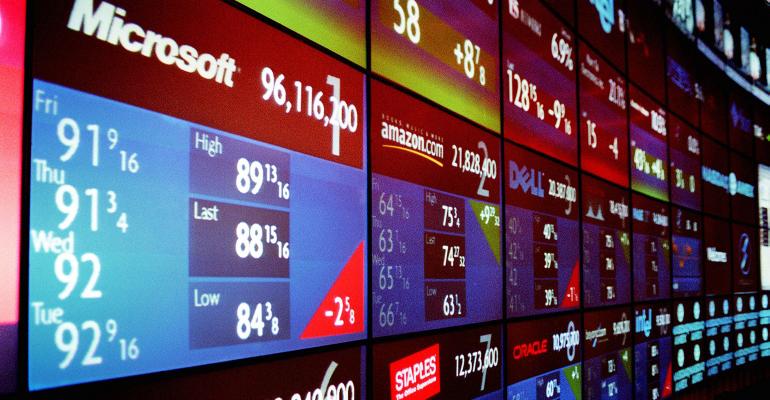(Bloomberg) -- A new ETF on Wall Street is offering investors a novel way to eke out income from the world of stocks by targeting an unlikely index: the Nasdaq 100.
Issuer Pacer ETF Distributors last week debuted a product that offers exposure to tech companies — more famous for furnishing growth than dividends — alongside amped-up income from the futures market. It joins a wave of new funds offering a slew of different ways to generate reliable income streams from equities of all stripes, often at the price of underperforming the broader market in a bull cycle.
The Pacer Metaurus Nasdaq 100 Dividend Multiplier 600 ETF launched with the ticker QSIX. It looks to give investors 85% exposure to the tech index, with the remainder used as collateral to buy dividends in the futures market in a bid to eke out six times what the Nasdaq 100 would pay out. It’s also a wager that tech stocks will start handing cash back to holders via dividend payments instead of spending it on share repurchases or research and development amid the AI boom.
Other sectors, like utilities and real estate, already pay far higher dividends. But Sean O’Hara, Pacer’s president argues tech giants like Apple Inc. or Microsoft Corp. are sitting on ready money, and will inevitably increase their payouts.
“When you think about the tech in the Nasdaq, there’s a distinct possibility because those big names in the index generate so much cash that they’ve got to do something with it,” he said. “And I suspect that over time most, if not all, of them will eventually start to pay dividends.”
The Nasdaq 100 is currently projected to pay a dividend yield of around 0.8% over the next year, which compares with 1.4% for the S&P 500, data compiled by Bloomberg show. But investors — especially stay-at-home ones — are salivating over income-generating strategies.
Currently, investors looking for yield can turn to dividend funds or ones that use derivatives to produce and distribute payments.
Derivatives-based funds — a group that includes products based on single companies, as well as so-called “buffer” ETFs that protect investors from falling prices, as well as leveraged funds — are increasingly popular. The class has attracted more than $43 billion year-to-date through Sept. 26 while 151 new funds have launched. That compares with around $36 billion of inflows and 150 new products in all of 2023, according to data compiled by Bloomberg Intelligence’s Athanasios Psarofagis.
Oftentimes, though, investors are giving up greater gains in a stock or index in return for upfront payments.
As these products proliferate, critics are warning that many of them, including leveraged or inverse single-stock funds based on a sole company, are risky given their volatility. Many have trailed the broader market while charging significantly more in fees. QSIX charges a 0.6% fee, which compares with the median rate of 0.5% across all ETFs, according to data compiled by Bloomberg.
While other strategies offering this trade-off are structured in such a way that investors give up some appreciation for a higher income stream, Pacer is looking to avoid investors having to take a big hit to performance, according O’Hara. Products in this category oftentimes use options to achieve their leverage targets, for instance, and reset on a daily basis. That can hurt performance because the daily rebalance of an options book dents returns over time. QSIX, instead, uses futures to reach for the boosted dividends — instead of leverage — something Pacer pointed to in its announcement for the launch of the fund.
Read More:
Yield-Crazed Day Traders Pony Up for ‘169%’ Option-Income ETFs
Like Nvidia for 0.03% Yield? Fidelity ETF Wins Big on Tech Bets
One-Day-Only ETFs Are Jack Bogle’s Nightmare Brought to Life
Pacer isn’t new to the category. In 2021, it debuted the Pacer Metaurus US Large Cap Dividend Multiplier 400 ETF, which sports a similar structure to QSIX but targets four times dividends on S&P 500 stocks.
Flows for the fund, which trades under the ticker QDPL, started to pick up earlier this year as the boom in income-generating products accelerated. So far this year, QDPL has taken in more than $250 million, putting it on track for its best annual inflow with its assets swelling above $500 million. Still, the ETF’s 20% return in 2024 is trailing the S&P 500’s 22% rally.
The new fund targets a larger multiple — versus the four times offered by the S&P 500-based fund — because Nasdaq 100 dividend futures are cheaper to purchase, according to O’Hara.





